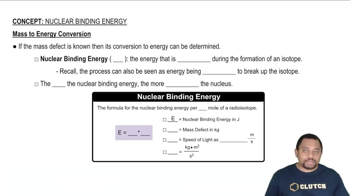Here are the essential concepts you must grasp in order to answer the question correctly.
Isotopes
Isotopes are variants of a particular chemical element that have the same number of protons but different numbers of neutrons. This means they share the same atomic number but have different mass numbers. For example, potassium-40 (40 19K) has 19 protons and 21 neutrons, while potassium-39 would have 19 protons and 20 neutrons.
Recommended video:
Atomic Number and Mass Number
The atomic number of an element, represented by the lower number in isotope notation, indicates the number of protons in the nucleus. The mass number, shown as the upper number, is the total count of protons and neutrons. For instance, in 40 19K, the atomic number is 19 (protons), and the mass number is 40, leading to the calculation of neutrons as 40 - 19 = 21.
Recommended video:
Nuclear Composition
The nuclear composition of an atom refers to the arrangement and quantity of protons and neutrons within its nucleus. Understanding this composition is essential for identifying isotopes and their properties. For example, knowing that 226 88Ra has 88 protons allows us to determine it has 138 neutrons (226 - 88 = 138), which is crucial for understanding its stability and behavior in nuclear reactions.
Recommended video:
 Verified step by step guidance
Verified step by step guidance


